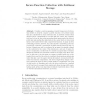Free Online Productivity Tools
i2Speak
i2Symbol
i2OCR
iTex2Img
iWeb2Print
iWeb2Shot
i2Type
iPdf2Split
iPdf2Merge
i2Bopomofo
i2Arabic
i2Style
i2Image
i2PDF
iLatex2Rtf
Sci2ools
ICALP
2009
Springer
2009
Springer
Secure Function Collection with Sublinear Storage
Consider a center possessing a trusted (tamper proof) device that wishes to securely compute a public function over private inputs that are contributed by some network nodes. In network scenarios that support direct communication of nodes with the center, the computation can be done by the nodes encrypting their inputs under the device's public key and sending the ciphertexts to the center which, in turn, feeds them to the trusted device that computes the function. In many modern networking scenarios, however, the center and the contributing nodes are not directly connected/ connectable, in which case the discovery and collection of inputs can only be performed by an agent (or agents) released to the network by the center. This introduces a new set of issues for secure computation. In this work we consider an agent that is released, sweeps the network once and then returns to its origin. The direct solution, in this case, is for the agent to possess a certified public key of the t...
| Added | 03 Dec 2009 |
| Updated | 03 Dec 2009 |
| Type | Conference |
| Year | 2009 |
| Where | ICALP |
| Authors | Maged H. Ibrahim, Aggelos Kiayias, Moti Yung, Hong-Sheng Zhou |
Comments (0)

